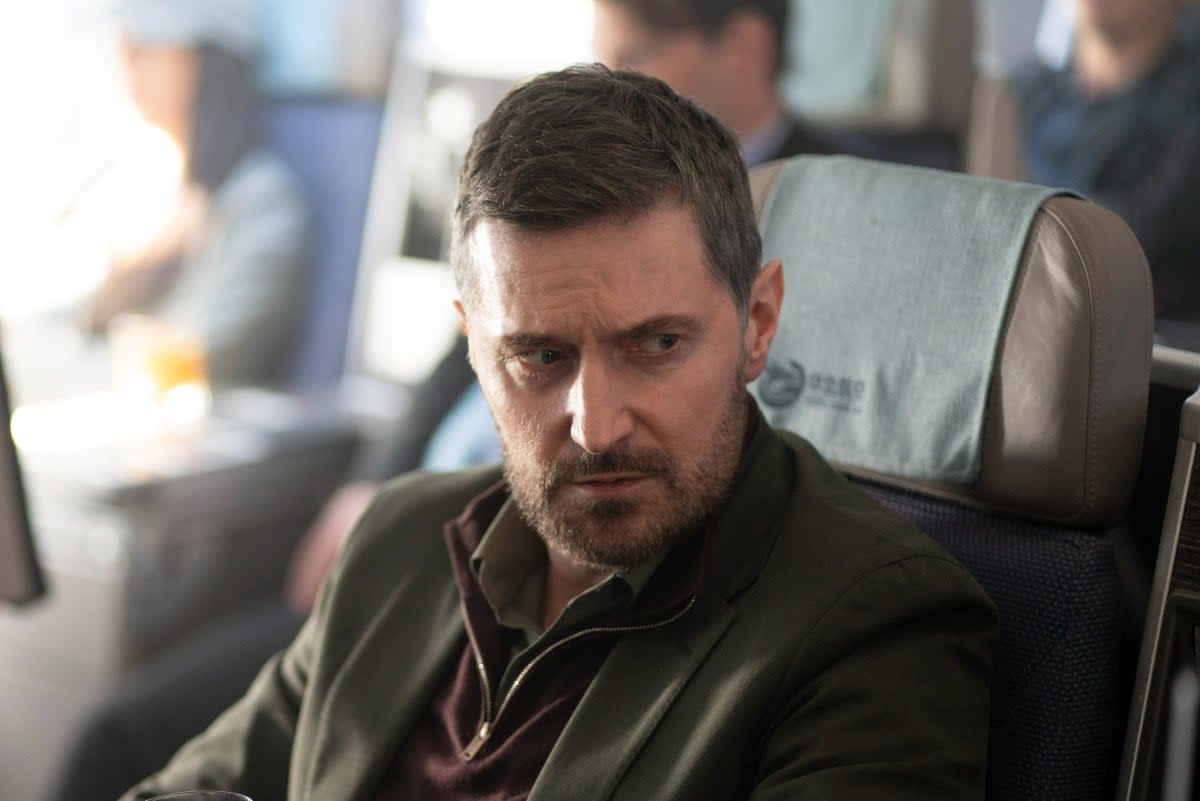Red Eye takes TV’s most reliably exciting premise and makes it nearly unwatchable

Does anyone actually look forward to flying? Some people actually fear it. Others grin and bear the tight legroom only because a person brings you alcohol to your seat at any time, around the clock. But one flight that is categorically not enjoyable is Red Eye.
The six-part series, which debuted on ITV over the weekend, follows a man (Richard Armitage) who arrives in the UK from a business trip to China, only to be immediately extradited back there to face charges for a murder he didn’t commit. Most of the series is set aboard the China-bound plane, which quickly becomes a crisis scenario for Armitage and his fellow passengers, including a shrewd law enforcement official played by Jing Lusi. They’re not having a nice flight, and neither are we. Because soon, the cabin is bursting with poison-laced ready meals, mounting bodies, and one increasingly hard-to-follow mystery.
It’s cheap and improbable stuff – a cavalcade of silly plot contrivances, shoddy dialogue, and stonily unintriguing political intrigue. On paper, the series should be impossible to sit through. Yet, as Nick Hilton writes in The Independent’s two-star review, Red Eye is “just about watchable – if only in the way that the in-flight map is watchable after a few too many bloody marys”. You see, there is something about Red Eye that scratches viewers’ coarse, pulpy itch for spectacle. It’s incredibly hard to make an aeroplane-set thriller dramatically uncompelling. Want to up the ante? Take to the skies! It’s a strategy as reliable as the laws of aerodynamics. Whether we’re talking Harrison Ford’s Air Force One, or last year’s Idris Elba miniseries Hijack, the simple setup of a hero, a plane, and a situation is all you really need. But why is it that aeroplanes make such fertile settings for adventure?
On the one hand, we have the claustrophobia of the aircraft itself. Staging action within the confines of a plane cabin creates an almost theatrical sense of time and place. There are hard boundaries over where characters can go and what they can do that immediately up the stakes of the situation. (This holds true even in something like Red Eye, which regularly cuts away to apposite drama back on UK soil involving intelligence boss Lesley Sharp.)
But unlike, say, a film set entirely within a warehouse, or a mansion, an aeroplane is also a dynamic environment. There is peril inherent just from the mere fact of being 40,000ft in the air, travelling at 500mph. In real life, the chances of a plane you’re on crash landing are pretty negligible; in the world of action cinema, planes tend to drop from the sky like gnats from an electric lamp. “These things go down! These things go down!” squawks Charles Grodin in 1988’s Midnight Run, trying to convince Robert DeNiro of his fear of flying. In the world of film and TV, at least, he wasn’t so very wrong.
A plane setting is basically a locked-room story in which the stakes are EXTREMELY high. Tense, potentially violent characters packed into a rocket-fast metal box with no way out. It’s a hard formula to mess up.
The fundamental appeal of Red Eye is not so very far removed from, say, Nicolas Cage’s Con Air, or 2005’s Flightplan, the Jodie Foster thriller written, as it happens, by Red Eye creator Peter A Dowling. But that’s not to say the genre hasn’t changed with the times.
It could be said that the airborne thriller has undergone two great sea changes over the decades. The first came in 1980, with the release of the hit parody film Airplane!. Such was the sheer eviscerating silliness of the comedy that it completely obliterated the subject of its parody, and put a kibosh on the sort of melodramatic disaster movies that had previously defined the genre. For two decades, Hollywood focused on grittier, less conventional aeroplane narratives, films such as 1992’s Passenger 57, or 1997’s Air Force One. And then, in 2001, two hijacked planes flew into the World Trade Center, and air travel became an entirely different proposition overnight. The danger was no longer far-fetched or titillating, and Hollywood largely opted to tread carefully around the imagery of air travel – fronting either reverent tales of true-life heroism (as in the 9/11 docudrama United 93) or silly genre exercises that could not be mistaken for reality (Samuel L Jackson’s hallucinatory Snakes on a Plane).
The emergence of TV series such as Hijack and Red Eye – as well as films such as the 2023 Gerard Butler thriller Plane – suggests that Hollywood has moved out of this post-9/11 mindset. Planes are free to be toyed with again, turned into arenas of violent spectacle. Gone too is any real sense of reality; in the first episode of Red Eye, Armitage is able to sprint around an airport causing mayhem, indulging behaviour that would in real life see him shot or tasered within seconds. Or at the very least barred from Heathrow Wetherspoons.
Red Eye won’t be a classic of the genre. It won’t even be the best-known Red Eye – that honour belongs to the 2005 plane-set thriller starring Cillian Murphy and Rachel McAdams. The ITV series seems to have flown from my mind before the wheels even touched down. But as a reminder of just how much value can be wrung from a premise, it’s illuminating. All you need is two wings, an engine and a cabin full of jeopardy – and then we have lift off.
‘Red Eye’ is available to stream on ITVX

 Yahoo News
Yahoo News 